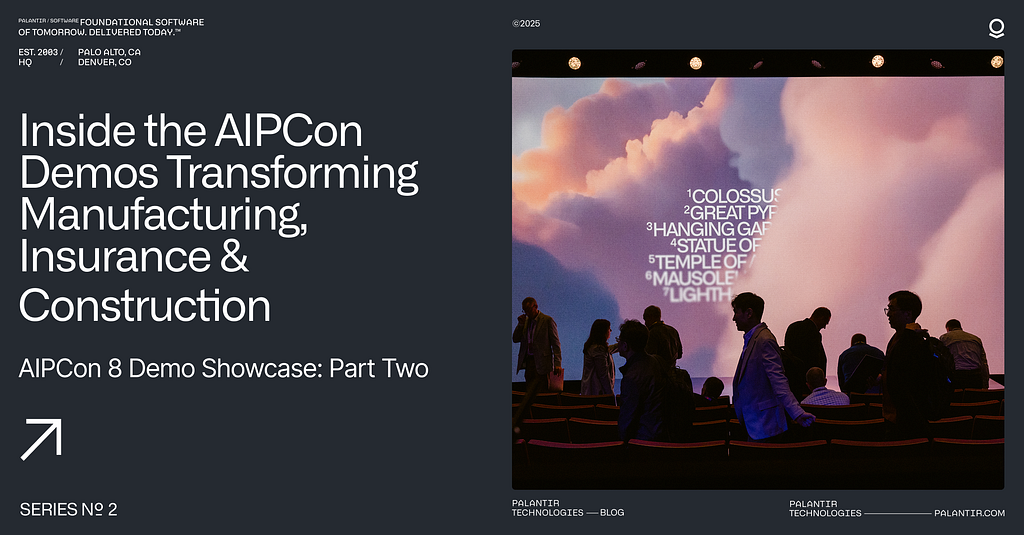
Editor’s Note: This is the second in a two-part series highlighting demo sessions from AIPCon 8, Palantir’s most recent customer conference. In part one, we shared how partners across healthcare, retail, defense, and beyond are leveraging Palantir Foundry and AIP to tackle their most pressing operational challenges.
AIPCon 8’s afternoon demo sessions showcased groundbreaking implementations across diverse industries. In part two of our coverage, we highlight four additional standout customers that demonstrate AI’s transformative potential across manufacturing, insurance, and construction.
These demos reveal how organizations are building entirely new operating models — from automated insurance underwriting that accelerates complex aerospace coverage decisions, to AI-native manufacturing execution systems that reimagine production workflows from the ground up.
What unites these implementations is a common thread: each customer has moved beyond experimentation to deploy production-ready systems that fundamentally reshape how their industries operate. Whether optimizing supply chain planning at scale, digitizing construction operations, or automating intricate brokerage workflows, these organizations prove that enterprise AI delivers its greatest impact when purpose-built around the unique requirements of each domain.
The demos that follow showcase not just what’s possible with AI — but what’s already happening in production environments today.
Ursa Major’s Ontology-Driven MES — AI-Native System for Next-Generation Aerospace
Ursa Major Technologies brought the intricacies of rocket science full circle as Nancy Cable, Director of Operations, unveiled their remarkable transformational journey from legacy low-tech processes to an AI-native, Ontology-driven Manufacturing Execution System (MES) powered by Palantir AIP. Through Warp Speed, Palantir’s manufacturing OS for American re-industrialization, they’ve systematically revolutionized their MES, converting static documentation into dynamic, interactive operational tools that error-proof and automate complex workflows — demonstrating that even the most sophisticated rocket engines can be fortified with the proper digital foundation.

From Static Documentation to Dynamic Manufacturing Intelligence
Nancy Cable’s demonstration showcased how Ursa Major has used AIP to fundamentally reimagine manufacturing documentation workflows through an intelligent digitization process. Traditional static documents — engineering drawings, work instructions, and compliance protocols previously trapped in PDFs and presentations — are ingested and transformed by AIP into digital workflows that adapt in real-time to manufacturing conditions and engineering changes. This helps Ursa Major automate their onboarding and up-skill their team, leveraging AI to rapidly place engineering expertise directly into the hands of those building their engines, every single day.
This transformation addresses a critical challenge in aerospace manufacturing: the gap between engineering intent and shop floor execution. By leveraging AIP to simplify document processing, Ursa Major automatically converts technical documentation into interactive manufacturing guidance that maintains engineering precision while enabling operational flexibility.
Ontology-Driven MES Architecture and Operational Intelligence
“We’re a hardware company. Eighty percent of our rocket engine components are 3D printed. That means we’re constantly scaling machines, building new fixtures, and updating tools,” Cable explained. “The physical infrastructure has to be supported by a digital layer that’s just as dynamic. When we need to build hundreds of engines, I need to know where every part is at any moment so we can make the best real-time decisions for quality and for our customers.”
Ursa Major’s comprehensive ontology facilitates seamless integration between engineering data and factory operations, enabling manufacturing intelligence that transcends traditional automation approaches. It also means everyone on the floor is working off the latest, most accurate source of truth. This unified platform architecture connects design specifications, manufacturing processes, quality requirements, and supply chain logistics into a cohesive operational framework, built to support real-time decision-making at enterprise scale.

AI-Powered Workflow Optimization and Error Prevention
The system’s sophisticated capabilities extend beyond documentation conversion. AIP is proactively error-proofing Ursa Major’s manufacturing with predictive analytics and automated quality gates. AIP continuously analyzes manufacturing processes, identifying potential bottlenecks, quality risks, and operational inefficiencies before they impact production timelines or product quality. The system isn’t just tracking what happens — it’s learning from it. If a step in assembly continually causes delays, AIP can flag it, recommend a fix, and notify the right engineer to rapidly expedite production.
The platform also eliminates manual setup steps, reducing the risk of human error while accelerating changeovers between different products and manufacturing configurations. This proactive approach to manufacturing intelligence enables Ursa Major to maintain the precision required for rocket engine manufacturing while achieving the production velocities necessary for commercial viability.
Seamless Role Transition and Operational Continuity
The demonstration showcased seamless handoffs between engineer and operator roles, highlighting how the platform eliminates traditional silos between design and manufacturing functions. Unlike rigid MES systems that force linear routing, Ursa Major’s operators can skip ahead to future steps when blocked — provided they have the right engineering sign-offs captured in the system. This means test engineers can update work instructions based on shop floor feedback in hours instead of weeks, eliminating the backlog of open issues traditionally stuck in review limbo.
Quantifiable Impact on Engineering Productivity
Ursa Major’s presentation highlighted measurable operational improvements achieved through their AI-native MES implementation.
“In just a few months, the tools we’ve deployed with Palantir are projected to save 10,000 to 15,000 hours of engineering time annually. That’s time we can reinvest into new designs, faster iteration, and tighter feedback loops.” — Ursa Major
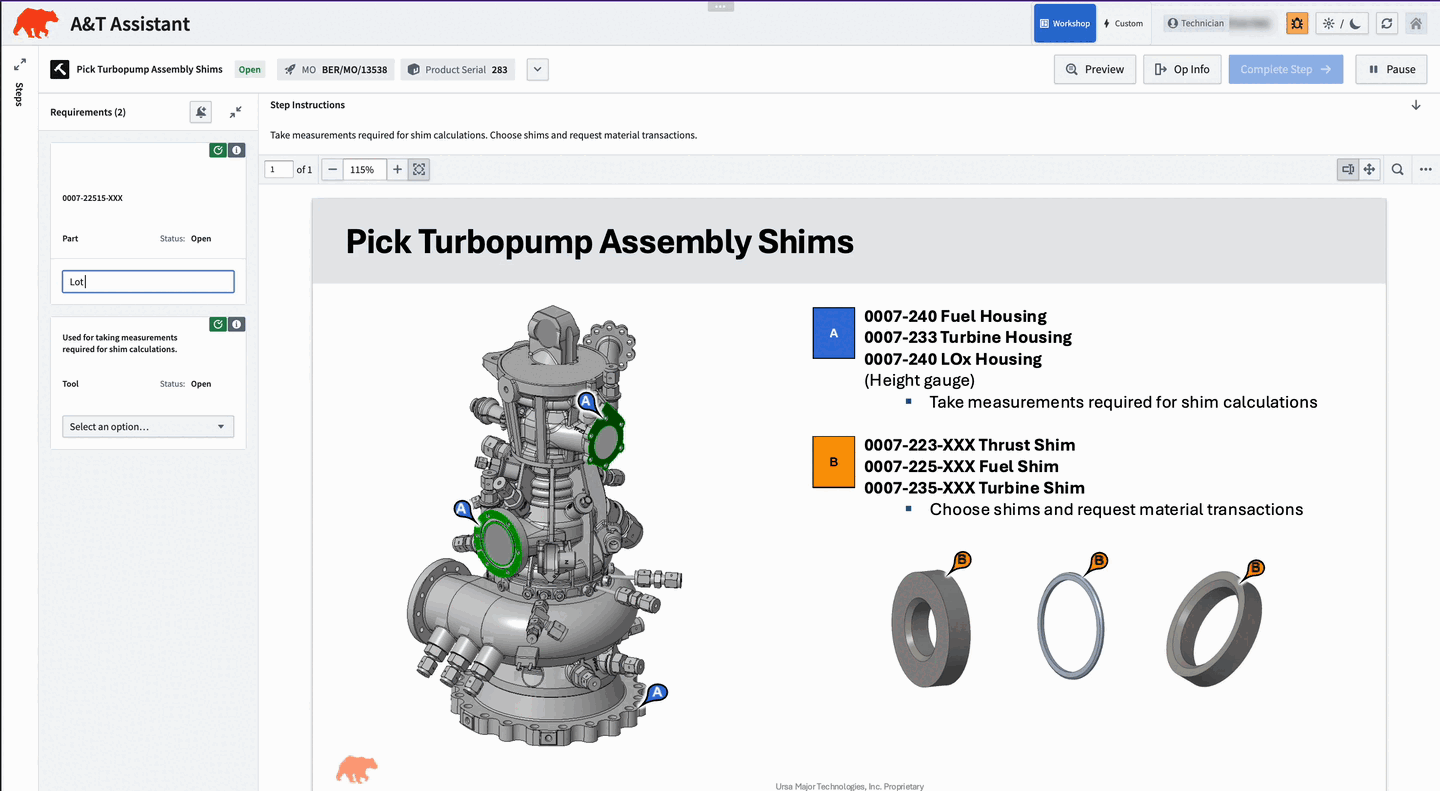
Strategic Transformation in Aerospace Manufacturing
Ursa Major’s implementation represents a paradigmatic transformation toward intelligent manufacturing systems that not only automate existing processes but fundamentally reimagine how aerospace components are designed, manufactured, and delivered. By connecting engineering data to factory operations through AI-driven intelligence, they’ve created manufacturing capabilities that enhance precision while enabling scalability — proving that sophisticated digital foundations can support the most demanding physical manufacturing requirements.
The result is a manufacturing execution system that operates as a living, adaptive platform rather than a static process management tool, enabling Ursa Major to compete effectively in the rapidly evolving aerospace market while maintaining the quality and reliability standards critical for mission-critical applications.
Epirus’s Implementation of MRPspeed Engine — Empowering Scalable, Data-Driven Supply Planning
Epirus’s implementation of MRPspeed, Warp Speed’s MRP (Material Requirements Planning) Engine, addresses a critical operational challenge for supply planning: systematically scaling beyond manual, spreadsheet-based workflows as business demands exponentially increase across engineering, supply chain, and finance. Epirus’s ontology, which consolidates data previously siloed between engineering and supply chain domains, ingests complex demand forecasting scenarios and algorithmically pinpoints the most impactful strategic actions to maintain production continuity.
This intelligent prioritization enables planners to rapidly execute data-driven decisions and proactively resolve material shortages that could negatively impact — or completely halt — operational workflows. Tasks that previously required painstaking manual analysis across disconnected systems are now streamlined into actionable intelligence, made accessible through intuitive interfaces. By transforming fragmented data ecosystems into consolidated insights, MRPspeed enables Epirus to drive measurable efficiency improvements and operational agility as supply chain complexity increases.

Strategic Architecture: CentaurOS Integration and Operational Scaling
The MRPspeed implementation supports Epirus’s broader “CentaurOS” strategic initiative — a comprehensive platform consolidation effort that unifies disconnected operational systems into a single, intelligent Foundry-powered environment. This integration enhances decision-making velocity and accuracy across organizational functions. This architectural transformation enables systematic elimination of manual bottlenecks that create exponential operational friction as business complexity increases.
The platform’s sophisticated capabilities were demonstrated through a test engineering optimization workflow that delivers 10x performance improvements, showcasing how intelligent automation can fundamentally transform operational efficiency rather than merely deliver incremental process improvements.
Eliminating Transactional Waste Through System Integration
John Juell, VP of Operations, and Kelsi McDonald, Operations Master Scheduler, from Epirus showcased their sophisticated implementation of Warp Speed, Palantir’s comprehensive manufacturing operating system. Their deployment has systematically eliminated “transactional waste” — the operational friction created when information transfers between disconnected teams and systems — by integrating previously isolated workflows and accelerating decision-making through closed-loop process automation.
Their demo revealed how test engineers, quality assurance teams, and manufacturing engineers now collaborate seamlessly through unified data flows, driving efficient production coordination across engineering, supply chain, and finance domains. This integrated approach addresses Epirus’s fundamental scaling challenge: existing manual processes that cannot accommodate growth even with proportional workforce expansion.
Advanced MRP and Supply Chain Intelligence
During the demo, Kelsi McDonald walked through how she leverages MRPspeed as a supply planner to replace manually intensive Excel-based workflows that, while functional for current operational states, cannot scale to support upcoming production volume increases. After running sophisticated demand scenarios powered by predictive analytics, she rapidly identified the right “needle in a haystack” action and made a prioritization decision based on what would have the greatest impact on Epirus’s business. Additionally, she showcased how MRPspeed’s algorithmic processing capabilities connect to Epirus’s ontology, helping to further synthesize the critical operational information that was previously siloed across domains.
The overarching value of this, McDonald highlighted, is that she can now take rapid action and source the right materials at the right time to meet demand, preventing production bottlenecks before they manifest.
Closed-Loop Process Optimization and Cross-Functional Visibility
The demo also highlighted Epirus’s systematic reduction of transactional waste between supply planning and procurement teams through automated system connections that enable real-time information flow and eliminate manual handoffs. Once McDonald sources a part, for example, the action is captured in the system and is immediately visible to her supply planning peers, the neighboring procurement team, and other teammates across Epirus who may be impacted. This provides closed-loop tracking and visibility for all stakeholders across the materials planning lifecycle, ensuring decision-making is coordinated and information transfer blockers are eliminated.
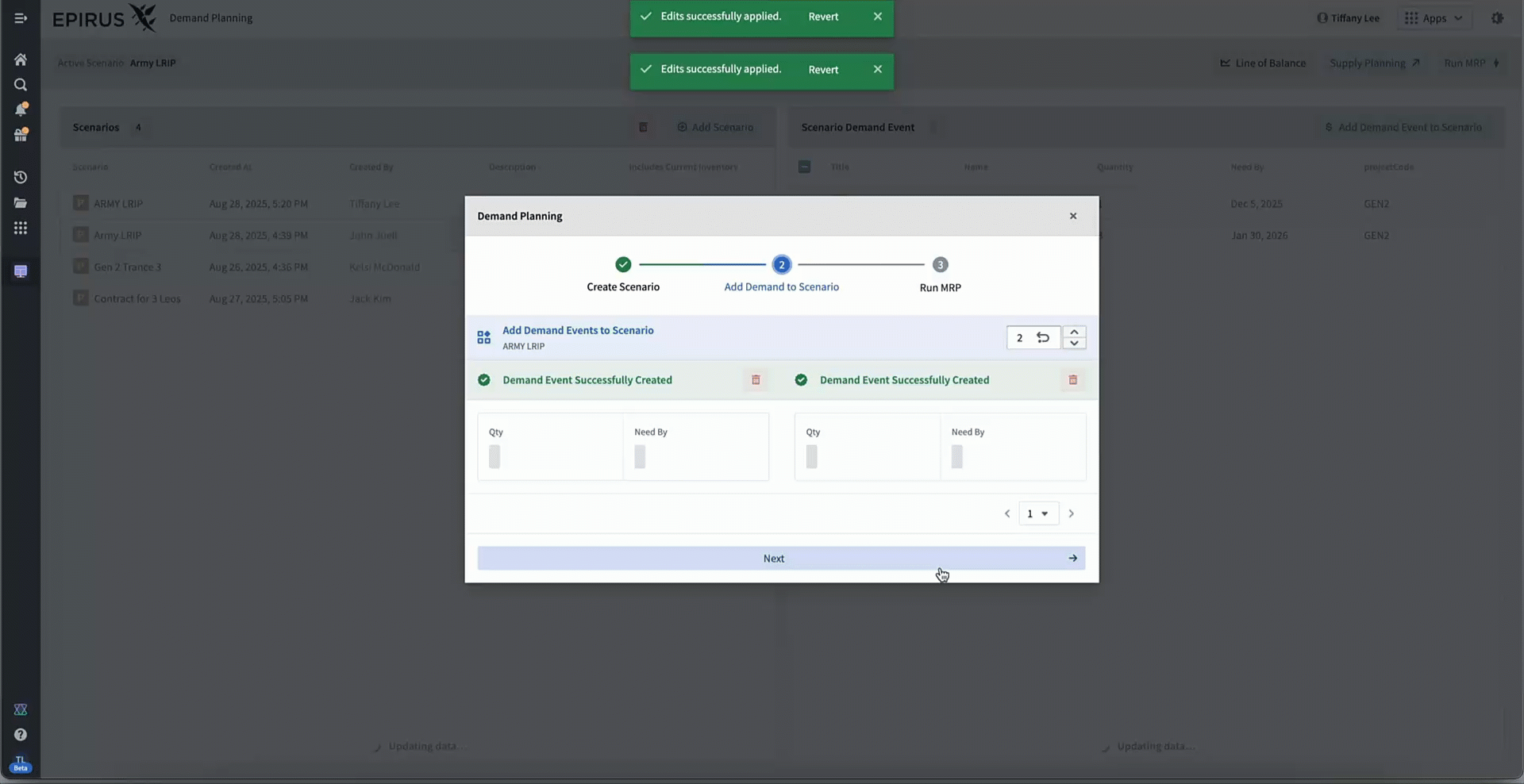
Transformational Impact on Manufacturing Operations
Epirus’s MRPspeed implementation represents a fundamental shift from reactive, manual supply planning to predictive, data-driven operational intelligence. It encodes business knowledge that previously didn’t exist in a system and enables Epirus to conduct rapid scenario planning. By systematically consolidating fragmented data sources and automating complex decision-making processes, Epirus has created scalable manufacturing operations that can accommodate exponential growth without proportional increases in complexity or workforce requirements, establishing new benchmarks for intelligent manufacturing systems integration.
Acrisure’s End-to-End Automated Insurance Brokerage Solution — Accelerating Aerospace Binding
Acrisure’s automated insurance brokerage solution addresses a longstanding operational challenge in aerospace broking: systematically streamlining the complex, multi-step application-to-bind process through intelligent workflow orchestration. Leveraging Palantir AIP’s sophisticated automation capabilities, the platform ingests customer requests across multiple channels — email submissions, digital portals, and integrated communication systems. It then automatically structures application data, identifies and resolves missing information gaps, and enriches submissions with validated third-party data sources before retrieving quotes from insurers.
Advanced AI agents, including those trained by experienced brokers to replicate expert decision-making processes, orchestrate real-time quote comparisons across multiple carriers to ensure optimal policy selection through algorithmic analysis. Tasks that traditionally required days of manual coordination and multi-stakeholder validation can now be completed in minutes through automated workflow execution with minimal human intervention.
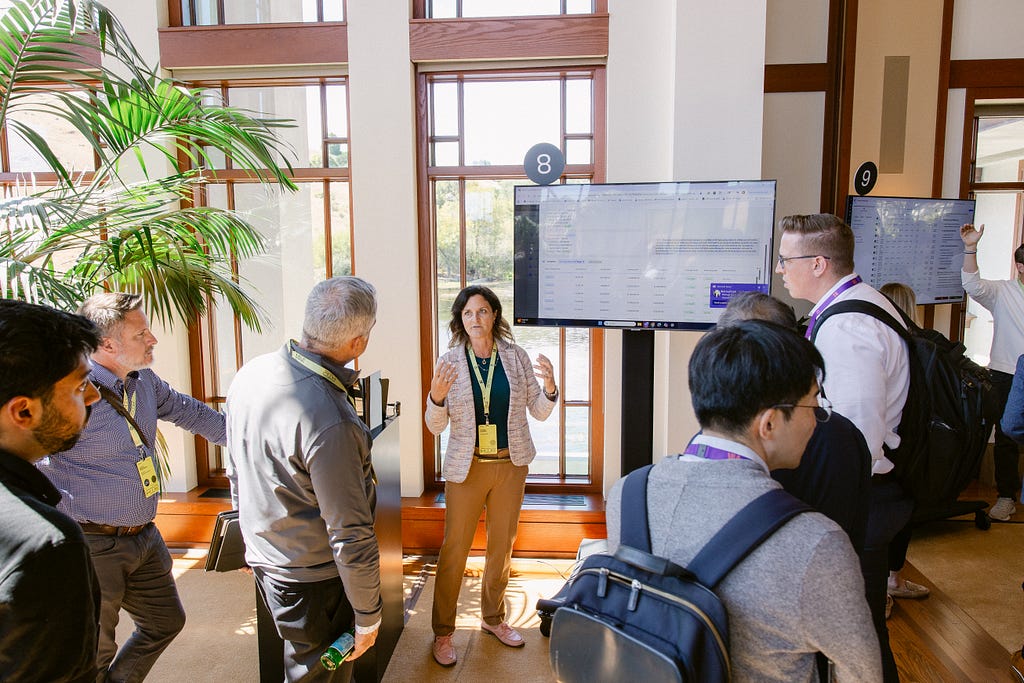
Intelligent Application Processing and Data Orchestration
Acrisure’s AIP-powered platform demonstrates sophisticated unstructured data ingestion capabilities through its customer intake workflow. When customers submit basic aircraft, pilot, and operational information via email, AIP automatically processes the unstructured email content and converts it into standardized application data objects within Acrisure’s ontology. This automated transformation eliminates manual data entry bottlenecks while ensuring data consistency across the underwriting pipeline.
The system then verifies application completeness, continuously monitoring submissions to identify missing required information through real-time data validation. When incomplete applications are detected, the platform flags specific data gaps and provides automated remediation pathways. Brokers can address the missing information manually through Foundry’s intuitive interfaces or leverage AIP’s audio transcription capabilities that automatically extract missing details from recorded phone conversations, facilitating seamless data capture.
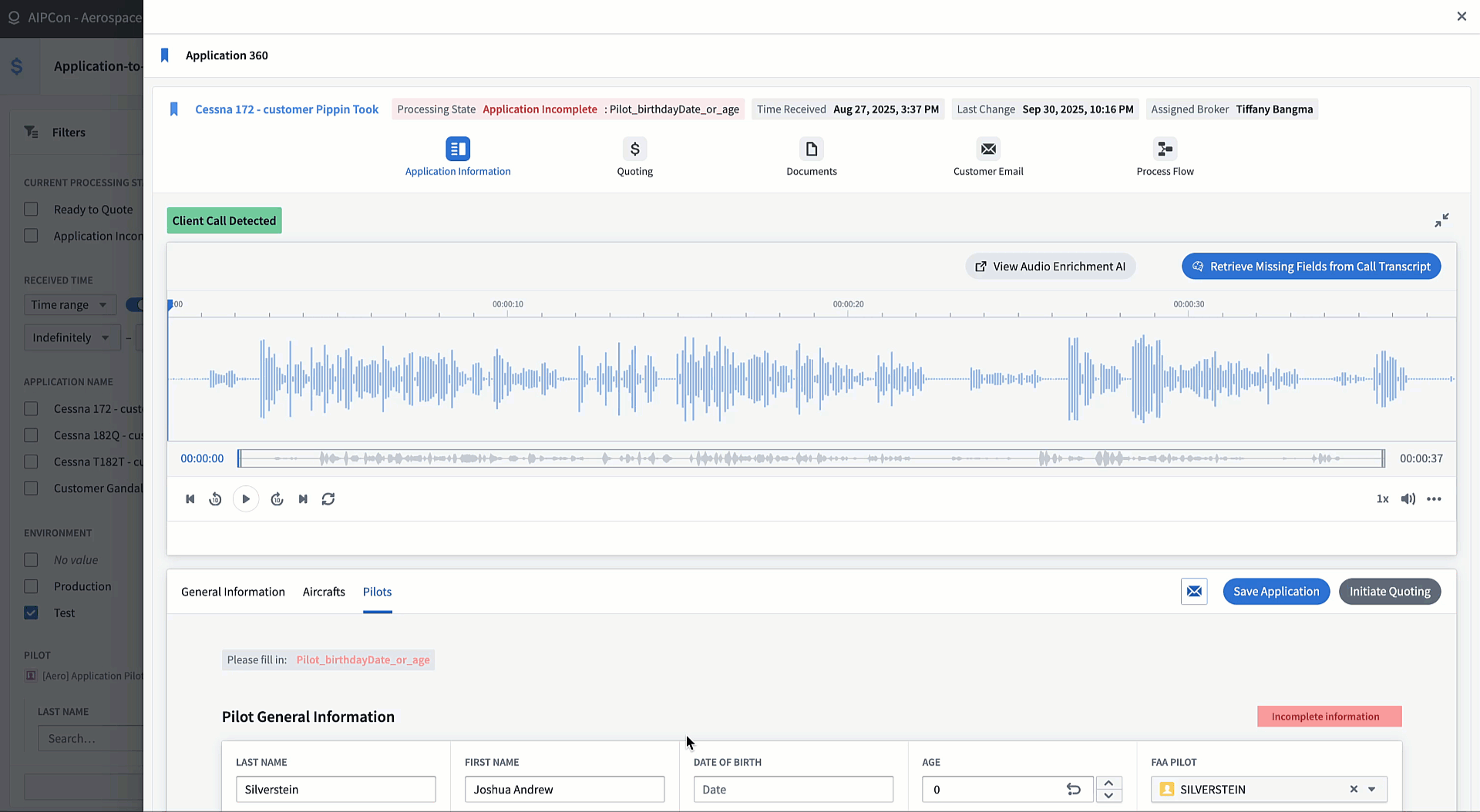
Third-Party Integration and Risk Assessment Intelligence
AIP’s automated data enrichment processes query external databases — including FAA pilot records and aircraft registration systems — to validate and supplement application data through API-based integrations. This systematic approach prevents processing errors and enables automated fraud detection by cross-referencing data across multiple sources, ensuring underwriting accuracy while accelerating validation timelines. The platform’s quote retrieval mechanism simultaneously requests quotes from multiple insurance carriers through standardized API connections. Complex backend translation algorithms convert the unique application data into the specified formats required by each carrier, while response parsing systems standardize incoming quotes into a unified framework that enables quick comparison. Altogether, these processes work in concert to allow Acrisure to run a systematic multi-carrier analysis.
AI-Powered Decision Intelligence and Expert Knowledge Transfer
The platform’s most sophisticated capability lies in its AI-powered quote analysis, where AIP agents compare available quotes across multiple decision factors — including pricing structures, coverage limits, internal carrier performance metrics, and policy terms. The system provides optimal policy recommendations based on expertise patterns extracted from senior brokers, essentially democratizing VP-level decision-making through AI agents that enhance junior broker analytical capabilities.
Automated Policy Binding and Workflow Completion
Upon customer approval of a recommended quote, the system automatically initiates carrier contact protocols to execute policy binding through integrated API workflows. The entire process — from initial customer inquiry through legally binding policy issuance — completes within minutes rather than traditional multi-day cycles, representing a fundamental transformation in the operational efficiency of aerospace insurance.
Strategic Impact on Aerospace Insurance Operations
Using Palantir AIP, Acrisure has architected an end-to-end automated insurance workflow that enables customers to progress from initial inquiry to legally binding policies ready for immediate deployment. The platform systematically democratizes expert broker knowledge through AI agent deployment while dramatically accelerating traditionally manual, multi-day processes into minutes-long automated workflows — setting new operational benchmarks for aerospace insurance broking efficiency and customer experience optimization.
Thomas Cavanagh Construction’s Central Operating System — Digital Transformation Through Unified Platform Architecture
Thomas Cavanagh Construction illustrates the transformational power of comprehensive technology integration. Joe Patrois, CET Development Strategist, showcased Cavanagh’s systematic enterprise-wide digital transformation, demoing how they’ve strategically replaced traditional fragmented systems with an integrated platform run on Foundry. They’ve achieved seamless operational management across ERP, human resources, labor coordination, and equipment allocation — all accessible through a unified homepage that’s available on both desktop and mobile. This empowers their global workforce to operate with lightning-fast operational responsiveness, from their back office to any job site.
This implementation transforms their operating model, taking them from reactive system management to proactive operational intelligence. In this new world, every technological decision is evaluated through a unified platform-first approach that eliminates system fragmentation and operational silos.
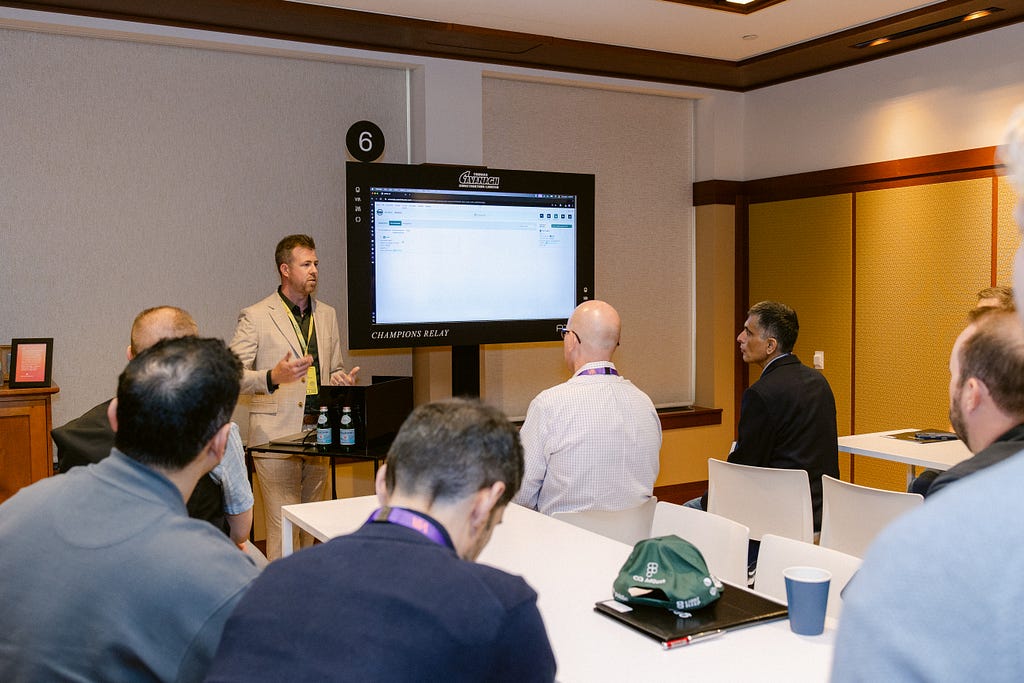
Foundry as Central Operating System Architecture
Patrois demonstrated how Cavanagh leverages Foundry as their company’s central operating system, fundamentally transforming team productivity through systematic workflow consolidation. He started by showcasing how their technology evaluation framework operates on a strategic principle: every new software requirement undergoes an assessment through the filter of “Can Foundry accommodate this functionality?” This approach ensures technological coherence and prevents the accumulation of disconnected systems that traditionally plague construction operations.
This unified platform strategy eliminates the operational friction created by multiple software interfaces, data transfer bottlenecks, and system integration challenges that typically limit construction industry productivity and scalability.
Enterprise-Scale Employee Management Through OSDK Development
Cavanagh’s workforce management app represents the next layer of their transformation journey, successfully deployed to over 1,000 employees across their organization. This comprehensive app governs all employee activities, HR information management, and digital timecards through a single, unified interface — eliminating the fragmented systems that typically complicate construction administration.
The app is powered by Palantir’s OSDK (Ontology Software Development Kit), enabling rapid deployment of custom enterprise applications while maintaining seamless integration with Cavanagh’s broader operational ecosystem. This approach ensures data consistency and workflow continuity across all employee touchpoints, from onboarding to daily operations.
Intelligent Equipment Management and Resource Optimization
Patrois presented their sophisticated equipment management orchestration system, which manages Cavanagh’s extensive machinery portfolio — including trucks, excavators, and specialized construction equipment — through an intelligent allocation workflow. The platform enables real-time equipment allocation across their employee network, comprehensive utilization tracking, and predictive maintenance scheduling that optimizes asset performance and operational efficiency.
This equipment intelligence system transforms traditional reactive maintenance and allocation processes into data-driven resource optimization that maximizes equipment utilization while minimizing operational downtime and maintenance costs.
AI-Powered Schedule Management and Customer Intelligence
The demo also showcased how Cavanagh is leveraging AIP to drive autonomous decisions. Patrois walked through how they seamlessly build, manage, and optimize work schedules with AIP, streamlining multiple operational variables simultaneously. He then highlighted the platform’s ability to automatically generate customer-facing reports in standardized formats, creating professional deliverables that maintain consistency while dramatically reducing manual effort and the traditional administrative burden that custom report creation requires.

Strategic Impact on Construction Industry Operations
Thomas Cavanagh Construction’s implementation marks another paradigm shift, moving operations toward unified construction intelligence. Traditionally disconnected operational domains — workforce management, equipment coordination, customer communications, and financial systems — now operate through seamless data integration and automated workflows.
By establishing Foundry as their central operating system, Cavanagh has created scalable construction operations that can accommodate business growth without proportional increases in operational complexity. This sets new benchmarks for integrated construction management platforms and demonstrates how comprehensive digital transformation can revolutionize traditional industry practices.
Decoding the Pattern: How to Architect AI for Operational Impact
Across both parts of our AIPCon 8 demo roundup, we’ve witnessed a defining moment in enterprise AI adoption. From healthcare diagnostics and retail operations in part one to aerospace manufacturing and construction management in part two, these implementations share a critical characteristic: they’re not prototypes or proof-of-concepts — they’re production systems delivering measurable operational transformation today.
What distinguishes these deployments is their systematic approach to industry-specific challenges. Ursa Major transforms static documentation into dynamic manufacturing intelligence. Epirus eliminates transactional waste across supply chain operations with algorithmic precision. Acrisure’s aerospace underwriting platform compresses multi-day workflows into minutes through intelligent automation. Thomas Cavanagh Construction unifies fragmented operational systems into a coherent digital infrastructure. Each represents a fundamental reimagining of how their respective industries operate at scale.
The pattern is unmistakable: organizations that architect AI around their unique operational requirements — rather than forcing generic solutions into complex workflows — achieve transformative results. These partners haven’t simply automated existing processes; they’ve built entirely new operating models that eliminate structural bottlenecks, democratize expert knowledge, and enable scalable growth without proportional increases in operational complexity.
As enterprises navigate their own AI transformation journeys, these implementations provide a blueprint: successful AI deployment requires deep domain integration, unified data architectures, and production-first mindsets that prioritize operational impact over experimentation.
→ Explore the full scope of innovation showcased at AIPCon 8, including additional demos, strategic insights, and technical deep-dives at palantir.com/aipcon/.
Inside the AIPCon 8 Demos Transforming Manufacturing, Insurance, and Construction was originally published in Palantir Blog on Medium, where people are continuing the conversation by highlighting and responding to this story.
